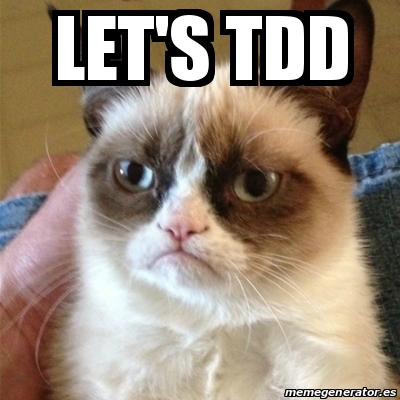TDD
For beginners
Created by Javi Martín and Miguel Olmos
What is TDD (Test Driven Development)?
- Development metodology
- Test before writting any code
Advantages
-
You'll only write the code needed
- KISS: Keep it simple stupid
- YAGNI: You aren't gonna need it
- Detect bugs while developing: cheaper
- Code more robust, higher quality, better maintainability
- Bye bye dead code
Advantages
- Increase your trust in your code
- Faster development
- Helps you to meet SOLID*
- It documents your code
- Drives you to use design patterns
Disadvantages
-
Learning curve
- Design patterns
- SOLID*
- Unit Testing knowledges
- Hard to apply over legacy code
TDD development cycle

TDD jargon
- Code coverage
- Asserts
- Unitary test
- Integration test
TDD jargon
- Mocks: Assert the mocked method is called without actually calling it
- Spy: Assert the mocked method is called and calls it
- Dummies: Override the mocked class and returns a default value
- Stubs: Return a fake value based on its input
Good practices
- Don't write logic
- One test method should assert an use case
- Clear test method names
-
Tests without interdependency
- Each test runs independently
- A test should be run without needing external dependencies
Good practices
- Only public methods are tested
- Dependency injection*
- Tests should run fasttttttttttt
SOLID principles
- Single responsibility
- Open-closed
- Liskov substitution
- Interface segregation
- Dependency inversion
Single responsibility
A class should have only a single responsibility
Open-closed
Open for extension, but closed for modification
Liskov substitution
Objects should be replaced by its subtypes without modifying the behaviour
Interface segregation
Many interfaces better than a generic one
Dependency inversion
Depend on abstractions not concretions
- Inject external dependencies
Let's play

FizzBuzz problem
Write a program that prints the numbers from 1 to 100. But for multiples of three print "Fizz" instead of the number and for the multiples of five print "Buzz". For numbers which are multiples of both three and five print "FizzBuzz?".
Rules
- Using TDD development cycle
- Pair programming
FizzBuzz problem
1
2
Fizz
4
Buzz
Fizz
7
8
Fizz
Buzz
11
Fizz
13
14
FizzBuzz
16
17
Fizz
19
Buzz
... etc up to 100
Reverse Polish Notation
Reverse Polish notation (RPN) is a mathematical notation in which every operator follows all of its operands, in contrast to Polish notation, which puts the operator in the prefix position. It is also known as postfix notation and is parenthesis-free as long as operator arities are fixed.
Reverse Polish Notation
5 1 2 + 4 * + 3 - = 14
2 5 3 + * = 16
2 1 12 3 / - + = -1